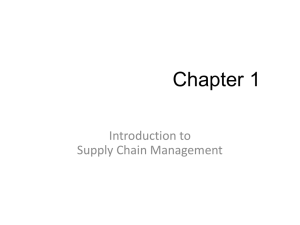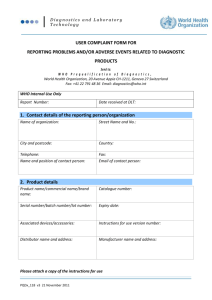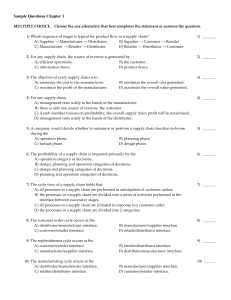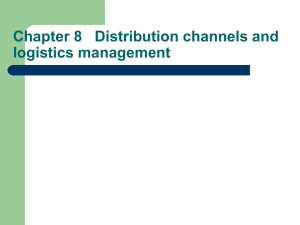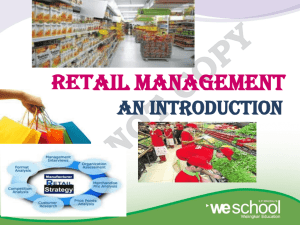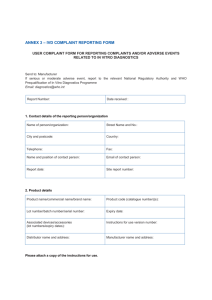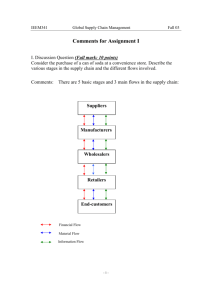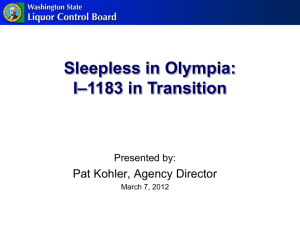IE3104: Intro to Supply Chain Modeling: Logistics
advertisement
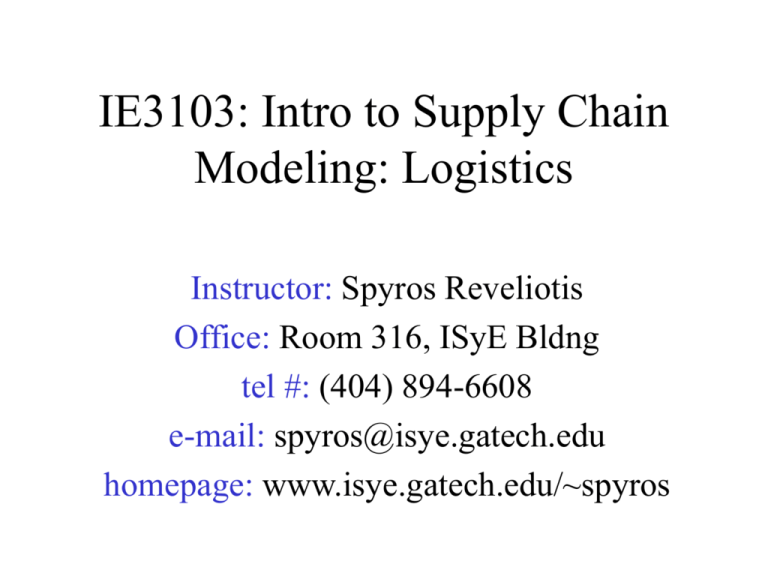
IE3103: Intro to Supply Chain Modeling: Logistics Instructor: Spyros Reveliotis Office: Room 316, ISyE Bldng tel #: (404) 894-6608 e-mail: spyros@isye.gatech.edu homepage: www.isye.gatech.edu/~spyros “Course Logistics” • TAs: – 3103A: Siddhartha Maheshwary – 3103B: Chayakrit Charoensiriwath • My Office Hours: 10:00-11:00am MWF (or email me and we shall arrange an appointment) • Grading policy: – – – – – – Homework: 25% Midterm I: 20% (Tent. Date: Monday, February 16) Midterm II: 20% (Tent. Date: Monday, March 29) Final: 35% (Date: TBA) Exams are closed-book, with 2 pages of notes per exam Make-up exams and Incompletes: Only for very serious reasons, which are officially documented. • Reading Materials: – Course Textbook: “Supply Chain Management” by S. Chopra and P. Meindl, Prentice Hall, 2001. – Material posted at my homepage or the library electronic reserves Course Objectives (What is this course all about?) • How to design and run contemporary supply chains – A systematic description of the operations taking place in contemporary supply chains – A conceptual characterization of the underlying design, planning and control problems – An introduction to the mathematical models and tools that can support the systematic analysis of the aforementioned problems – Familiarization with the computational tools that can support the implementation of the methodology presented in class (mainly through homework assignments) So, what is a supply chain? Chopra & Meindl: A supply chain consists of all stages involved, directly or indirectly, in fulfilling a customer request. Example: A detergent supply chain: Manufacturer (P&G) Wal-Mart DC Chemical Manufacturer Plastic Producer Tenneco Packaging Oil Industry Timber Paper Manufacturer Industry Wal-Mart Store Customer A more abstract characterization of a supply chain / network Carriers Supplier Manufacturer Distributor Retailer Customer Supplier Manufacturer Distributor Retailer Customer Supplier Manufacturer Distributor Retailer Customer Material Information Funds Remark: Although the modern world is much messier…. A cycle-based process view for supply chain operations Cycles: A sequence of steps characterizing the transactions that take places among two successive stages of the supply chain Stages Customer Customer Order Cycle Retailer Replenishment Cycle Distributor Manufacturing Cycle Manufacturer Procurement Cycle Supplier Customer order cycle • All the processes directly involved in receiving and filling a customer order. • Major phases: – Customer Arrival (at a retail store, telemarketing center, company web site) Phase Objective: maximize customer arrivals to customer orders – Customer Order Entry Phase Objective: ensure that the order entry is quick and accurate and is communicated to all other supply chain processes that are affected by it. – Customer Order Fulfillment Phase Objective: get the correct and complete orders to the customer, by the promised due date and at the lowest possible cost – Customer Order Receiving – Phase Objective: Complete the transaction in an orderly fashion Replenishment Cycle • All the processes involved in replenishing retailer inventory. • The primary objective: Replenish inventories at the retailer at minimum cost, while providing a certain product availability to the customer. • Major Phases: – – – – Retail Order Trigger (by an appropriate replenishment policy) Retail Order Entry Retail Order Fulfillment Retail Order Receiving Manufacturing Cycle • All processes involved in generating the product that will fill the customer, retailer and distributor orders. It is driven by – the actual orders placed with the manufacturer, – forecasts for expected future demand, and – the current product availability in the manufacturer’s finished-product warehouse. • Primary objective: Meet the actual and/or forecasted demand in a timely and cost-effective manner, within the scope of the available production capacity • Major Phases: – – – – Order arrival from distributor, retailer or customer Production Scheduling Manufacturing and shipping Receiving at the distributor, retailer, or customer Procurement Cycle • All the processes necessary to ensure that materials are available for manufacturing to occur according to schedule. • Major Phases: similar to the cycle characterizing the interaction between distributor and manufacturer. • However, demand is driven by the manufacturer’s production schedule rather than more exogenous market factors / customer behavior. A push vs pull view of the SC operations Categorizes SC processes based on whether they are initiated in response to a customer order (pull) or in anticipation of a customer order (push). Examples: • Compaq: All processes except for those involved in customer order cycle are of “push” type. • Dell: Dell assembles its computers to order and therefore, all processes except for those involved in the procurement cycle are “pull”. Remark: Generally, if possible, a “pull” organization of the supply chain provides tighter control of inventory costs and the ability to support higher levels of product customization. Some definitions for Logistics and Supply Chain Management • Council of Logistics Management (CLM): The process of planning, implementing and controlling the efficient, effective flow and storage of goods, services, and related information from the point of origin to the point of consumption for the purpose of conforming to customer requirements. • Chopra and Meindl: The primary purpose for the existence of any supply chain is to satisfy customer needs, in the process generating profits for itself. Supply chain activities begin with a customer order and end when a satisfied customer has paid for his or her purchase. A problem break-down • Strategy or design issues: How to structure the supply chain (scope: years) – Logical configuration of the supply chain processes and their various operational cycles – Physical configuration of the supply chain • Location and Capacity of Production and Storage facilities • Transportation links and modes – Information technology (IT) infrastructure • Planning issues: Determining the operational policies that will drive the short-term decision making (scope: months) – – – – Which markets to be supplied by which locations Planned Build-up of inventories / Inventory replenishment policies /Stockout handling Levels of subcontracting Timing and size of marketing promotions • Operational issues: Implement the operating policies in the best possible manner (scope: shifts, days or weeks) – – – – – – Allocate individual orders to inventory or production Set a date that an order is to be filled Generate the pick lists for a warehouse Allocate an order to a particular shipping mode and shipment Set delivery schedules for trucks Place replenishment orders Reading Assignment • Read Chapters 1, 2 and 3 from your textbook.

